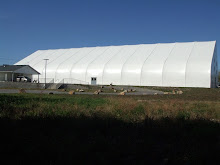Several of us at CCSC train using a method loosely called "clicker training." It's one of the training methods used in some of our classes, so I thought I'd start a bit of a conversation about clickers and what they are and what they can do. Before getting into the subject though, it should be pointed out that there are many positive training methods out there, and clicker training is just one of those. One of the fun things about training is exploring different methods to find ones that work best for you and your dog. As an example, though I clicker train, I also use voice rewards, toys, play, etc. in my training. It's all about having tools in the toolbox.
Clicker training as a subject is far too big for a single post (and besides, I know that the rest of our crew here on CCSC Dog Talk will also weigh in). But I'll start the ball rolling by describing some of the science behind the clicker. Hopefully you won't doze off, because it's actually pretty cool.
I think everybody has heard of Pavlov's dogs. You know, hungry dogs, salivating for dinner. A bell was rung before dinner was served and pretty darn quick, the dogs began salivating just at the sound of the bell, even when food wasn't present. The type of training that was called is Classical Conditioning. And the device, the bell, was a classically conditioned tool. The bell told the dogs to expect something--food. The bell meant that one thing and only that one thing. The dogs knew it, they understood it.
Well there was this other guy, too. By the name of B.F. Skinner. And back in the 1930s he published research into another type of learning, called Operant Conditioning. Basically, Operant Conditioning means that behavior has consequences. And all dog training and is based in some form of Operant conditioning. We humans also learn this way. I'm not going to go into detail about Operant Conditioning today. Just remember the term, because you'll hear it if you train dogs with a knowledgeable trainer.
The important thing to remember is that once a dog has learned that a certain sound always means food, he can learn that certain of his behaviors can have the consequence of getting to hear that sound; which will reward him with food. In other words, he learns to work for that sound.
Today we don't use a bell (they can clang when you don't want them to and don't fit real well in a pocket). We use a clicker. The clicker makes a sharp, audible sound. We use it to mark a behavior we want to reward the dog for doing. As an example, we could click the dog for sitting, or for watching us, or for a correct weave entry. Lots of things.
Why a clicker? Why not just praise?
Some trainers, including some of the instructors at CCSC, use only voice and are extremely successful. But clickers may be more effective than voice to mark a dog's success. Why? Because it's not voice. I know that sounds weird. But dogs have been bred for thousands of years to be exquisitely sensitive to our voice inflections and tone. And when we praise, we always put emotion into that praise. Unfortunately, the praise or "Yes" we say when we are happy and energized and training is going really well is often quite different than the "Yes" we say when we're tired and everything has gone wrong. It's just the way we humans are. And dogs read the real emotions behind the words. So when we grind that "yes" out with our teeth gritted, they know we still aren't happy.
The beauty of the clicker is that it is entirely black and white to the dog. It says one thing and only one thing. "This is what I wanted. You get a treat!" Because it's so unambiguous, and because it is divorced from emotion, dogs really get it. And because they understand it completely, the clicker becomes a tremendously powerful tool.
The second reason why clickers may work better than voice is timing. Studies have shown that we can click with our thumb (or finger) faster than we can process a verbal word, send it to our brain, have the brain send it to our vocal cords, and voice it. Dogs also process it much faster. Instead of having to figure out what word the human is saying, they get this brief noise with a very clear meaning. There's some evidence that clicking may connect directly to the dog's limbic, producing a stimulus response (see Karen Pryor link by clicking here).
Karen Pryor's site is a great one to start with if you want more information on clicker training.
—Robin
Tuesday, January 8, 2008
Click what?
at
3:49 PM
![]()
![]()
Labels: Clicker Training, Training
Subscribe to:
Post Comments (Atom)




No comments:
Post a Comment